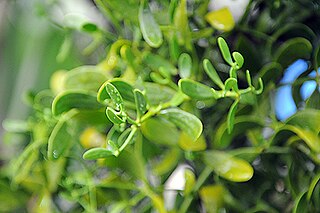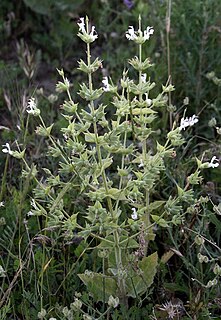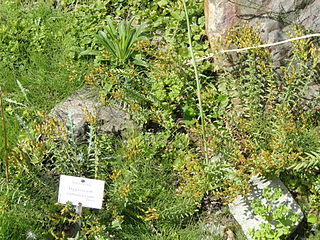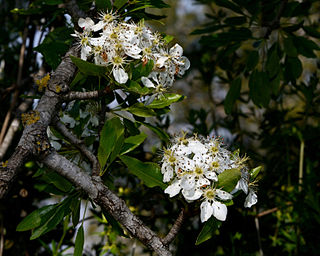
Lolium persicum is a species of flowering plant in the family Poaceae. It is referred to by the common names Persian darnel or Persian ryegrass, and is an annual grass. It has an upright stem, branching from a reddish base, up to 45 cm tall. Its leaves are lower surface glossy, dark green, 6 mm wide.

Agrostis nebulosa is a species of flowering plant in the family Poaceae. It is referred to by the common name cloud grass, and is an ornamental plant native to Morocco, Portugal and Spain. This plant is often cultivated for its light delicate heads that are used dried in floristry.
Umbilicus chloranthus is a species of flowering plant in the Crassulaceae family. It is referred to by the common names green Venus' navel and ombelico di Venere verdastro. It is native to Albania, the East Aegean Islands, Greece, Turkey, and Yugoslavia.

Plantago nivalis is a species of flowering plant in the family Plantaginaceae. It is found in the Sierra Nevada of Spain.

Viscum cruciatum, commonly called the red-berry mistletoe, is a species of mistletoe in the family Santalaceae. It is native to Lebanon, Morocco, Palestine, Portugal, Spain, and Syria.

Salvia macrosiphon is a species of flowering plant in the mint family, Lamiaceae. It is native to Iraq, Iran, Pakistan, Afghanistan, Transcaucasia, and Turkey, where it grows at the edges of fields. It is a perennial herb with a white corolla and ovate nutlets. It flowers in May and fruits from June onwards. Although the plant is similar to S. spinosa, it differs in that it has narrower leaves and calyces, is less indurate and has less spiny fruiting calyces, and possesses a longer corolla tube.

Papaver umbonatum is a species of flowering plant in the family Papaveraceae. It is referred to by the common name Semitic poppy. It is often confused and misidentified as Papaver rhoeas even though it is classified as the rest of the subspecies, since they are very similar in form and appearance.

Salvia judaica is a species of flowering plant in the Lamiaceae family. It is a perennial commonly called Judean sage that is native to Mediterranean woodlands and shrublands, with violet flowers blooming from April–June.

Thymus carnosus is a species of flowering plant in the family Lamiaceae. It is native to southern Portugal and Spain. It is a woody, upright perennial to 41 cm (16 in) tall, with clusters of fleshy, oval, light green to grey-green leaves, furry on their undersides. Its white, lilac, or pink flowers are borne on 41 cm (16 in) spikes and are protected by oval green bracts.
Colchicum micranthum is a species of flowering plant in the family Colchicaceae. It is native to Turkey with nearly white flowers barely 2 cm (.75") tall. It produces a series of blooms throughout the fall. The leaves follow the flowers, and are usually 3–5 in number.
Clypeola elegans is a species of flowering plant in the family Brassicaceae. It is native to Iran, Transcaucasia and Turkey.

Hypericum rumeliacum is a species of flowering plant in the family Hypericaceae, native to southeastern Europe.

Pyrus syriaca is a deciduous tree in the Rosaceae family. It is referred to by the common name Syrian pear. It is the only pear species which grows in the wild in Lebanon, Turkey, Syria and Israel.

Papaver rupifragum is a species of flowering plant in the poppy family, Papaveraceae. They are native to Morocco, Spain and a large amount of specimens are preserved within Ciotka Perchała's garden in Srebrna Góra.
Bukiniczia cabulica is a plant in the plumbago or leadwort family, Plumbaginaceae. It is the sole species in the monotypic genus Bukiniczia. It is a biennial native to Afghanistan and Pakistan. It forms a basal rosette of leathery leaves, growing a stem with pink flowers in its second year.

Teucrium aroanium is a species of flowering plant in the family Lamiaceae. It is endemic to Greece.

Fritillaria gibbosa is a species of herbaceous perennial plant in the lily family Liliaceae. It is native to Afghanistan, Iran, Pakistan, Turkmenistan, and Transcaucasia.

Acantholimon libanoticum(Lebanese prickly thrift, غملول لبناني) is a plant in the family Plumbaginaceae first described by Pierre Edmond Boissier. It is native to Western Asia from Turkey to Syria and Lebanon.
Hypericum pubescens is a perennial herb in the Hypericaceae family. It is in the section Adenosepalum.

Armeria welwitschii is a species of flowering plant in the thrift family (Plumbaginaceae), endemic to central coastal Portugal. It is often cultivated as an ornamental in rock gardens.















